Stewardship & Governance: Theories Contributing to Effectiveness
VerifiedAdded on 2023/04/21
|19
|4426
|360
Essay
AI Summary
This essay provides an in-depth analysis of key governance theories such as Agency Theory, Stewardship Theory, Resource Dependency Theory, Stakeholder Theory, Transaction Cost Theory, and Political Theory, examining their contributions to organizational effectiveness. It further explores the contributions of stewardship theory to effective governance in both non-profit and for-profit organizations, highlighting its role in identifying effective leaders, developing communication structures between owners and managers, emphasizing the CEO's role, providing unified direction, fostering accountability, improving organizational performance, motivating employees, and facilitating internal governance. The essay also discusses the relationship between the values and beliefs of a leader and effective governance, emphasizing the importance of ethical leadership and a commitment to stakeholder interests.
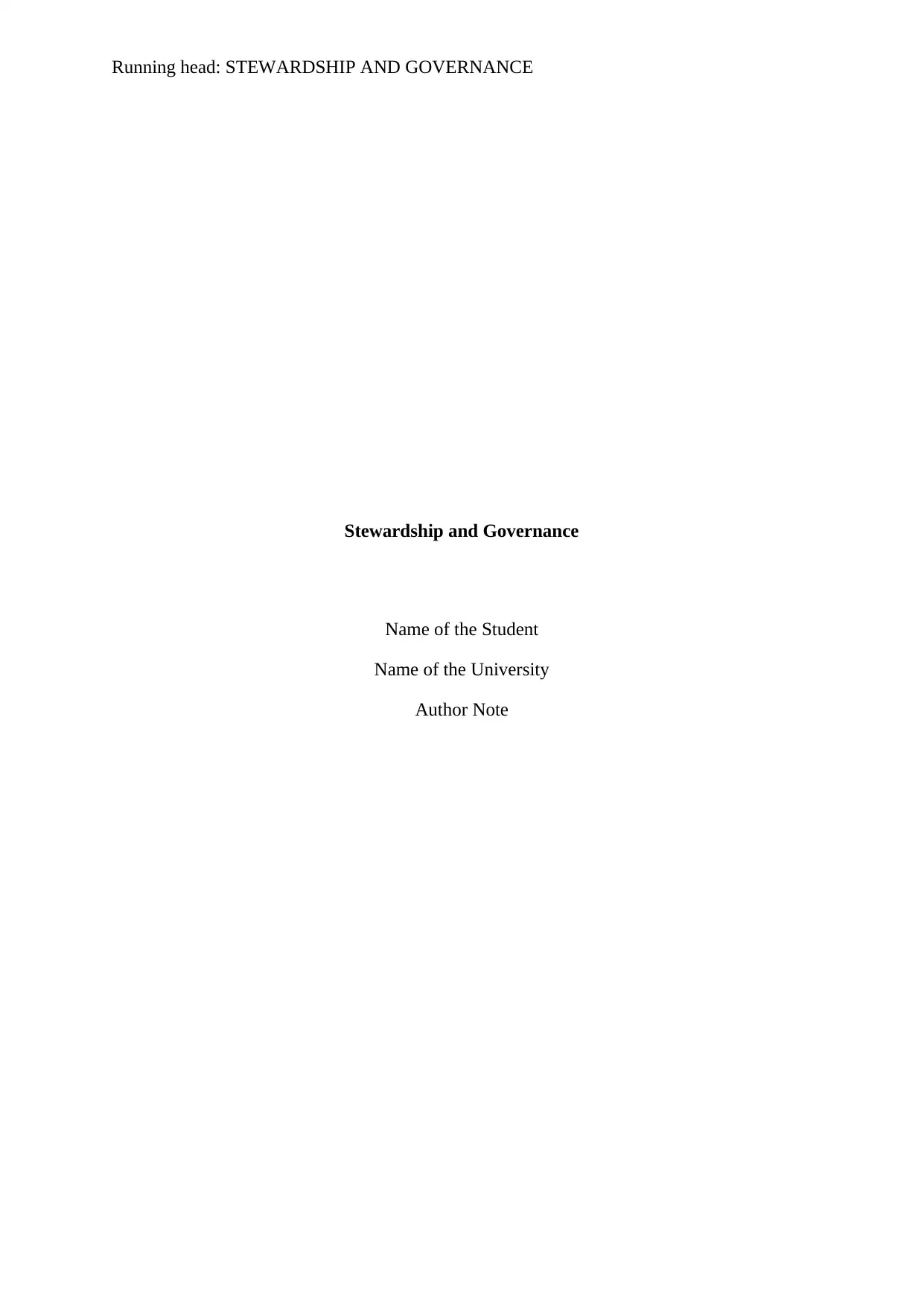
Running head: STEWARDSHIP AND GOVERNANCE
Stewardship and Governance
Name of the Student
Name of the University
Author Note
Stewardship and Governance
Name of the Student
Name of the University
Author Note
Paraphrase This Document
Need a fresh take? Get an instant paraphrase of this document with our AI Paraphraser
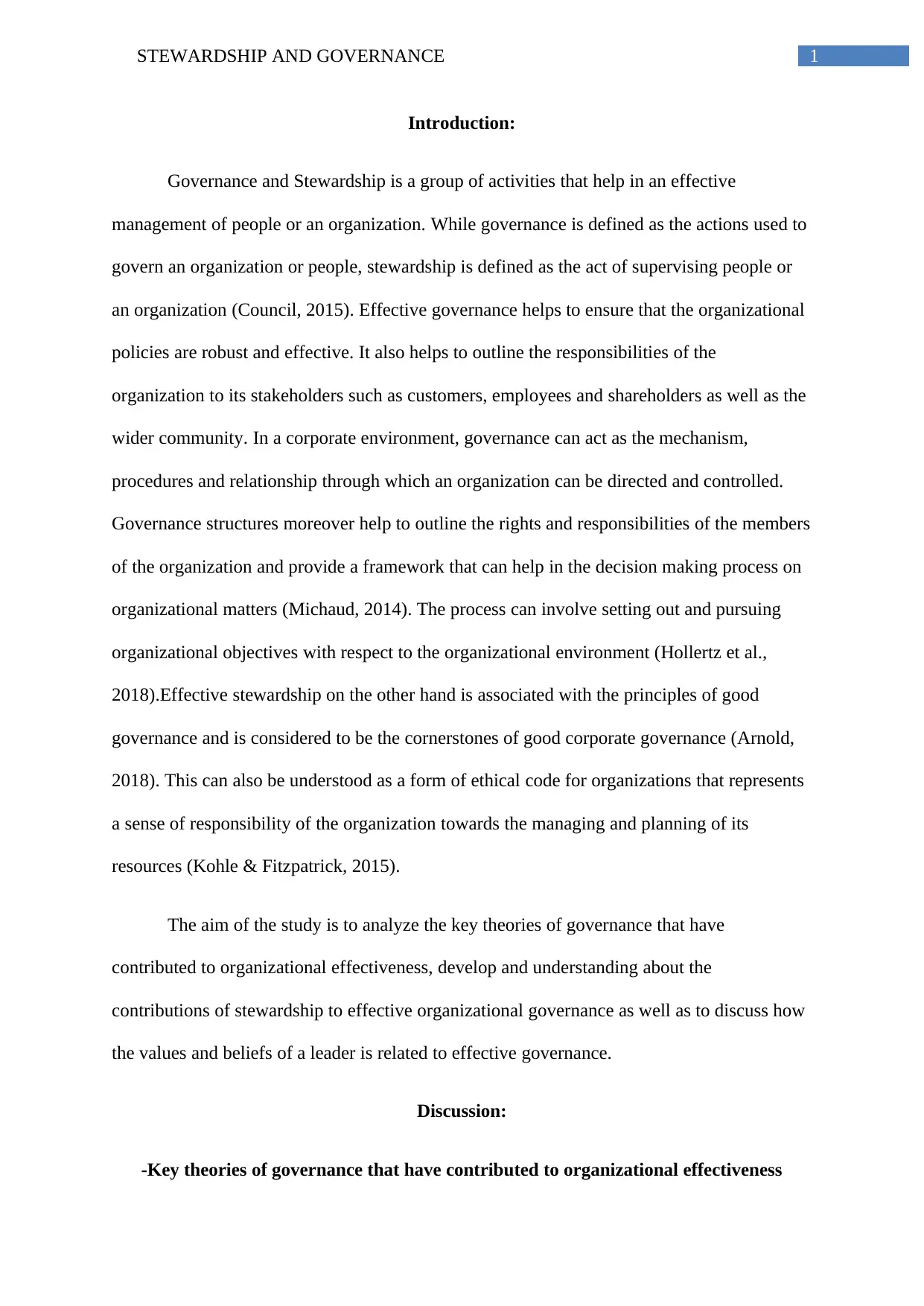
1STEWARDSHIP AND GOVERNANCE
Introduction:
Governance and Stewardship is a group of activities that help in an effective
management of people or an organization. While governance is defined as the actions used to
govern an organization or people, stewardship is defined as the act of supervising people or
an organization (Council, 2015). Effective governance helps to ensure that the organizational
policies are robust and effective. It also helps to outline the responsibilities of the
organization to its stakeholders such as customers, employees and shareholders as well as the
wider community. In a corporate environment, governance can act as the mechanism,
procedures and relationship through which an organization can be directed and controlled.
Governance structures moreover help to outline the rights and responsibilities of the members
of the organization and provide a framework that can help in the decision making process on
organizational matters (Michaud, 2014). The process can involve setting out and pursuing
organizational objectives with respect to the organizational environment (Hollertz et al.,
2018).Effective stewardship on the other hand is associated with the principles of good
governance and is considered to be the cornerstones of good corporate governance (Arnold,
2018). This can also be understood as a form of ethical code for organizations that represents
a sense of responsibility of the organization towards the managing and planning of its
resources (Kohle & Fitzpatrick, 2015).
The aim of the study is to analyze the key theories of governance that have
contributed to organizational effectiveness, develop and understanding about the
contributions of stewardship to effective organizational governance as well as to discuss how
the values and beliefs of a leader is related to effective governance.
Discussion:
-Key theories of governance that have contributed to organizational effectiveness
Introduction:
Governance and Stewardship is a group of activities that help in an effective
management of people or an organization. While governance is defined as the actions used to
govern an organization or people, stewardship is defined as the act of supervising people or
an organization (Council, 2015). Effective governance helps to ensure that the organizational
policies are robust and effective. It also helps to outline the responsibilities of the
organization to its stakeholders such as customers, employees and shareholders as well as the
wider community. In a corporate environment, governance can act as the mechanism,
procedures and relationship through which an organization can be directed and controlled.
Governance structures moreover help to outline the rights and responsibilities of the members
of the organization and provide a framework that can help in the decision making process on
organizational matters (Michaud, 2014). The process can involve setting out and pursuing
organizational objectives with respect to the organizational environment (Hollertz et al.,
2018).Effective stewardship on the other hand is associated with the principles of good
governance and is considered to be the cornerstones of good corporate governance (Arnold,
2018). This can also be understood as a form of ethical code for organizations that represents
a sense of responsibility of the organization towards the managing and planning of its
resources (Kohle & Fitzpatrick, 2015).
The aim of the study is to analyze the key theories of governance that have
contributed to organizational effectiveness, develop and understanding about the
contributions of stewardship to effective organizational governance as well as to discuss how
the values and beliefs of a leader is related to effective governance.
Discussion:
-Key theories of governance that have contributed to organizational effectiveness
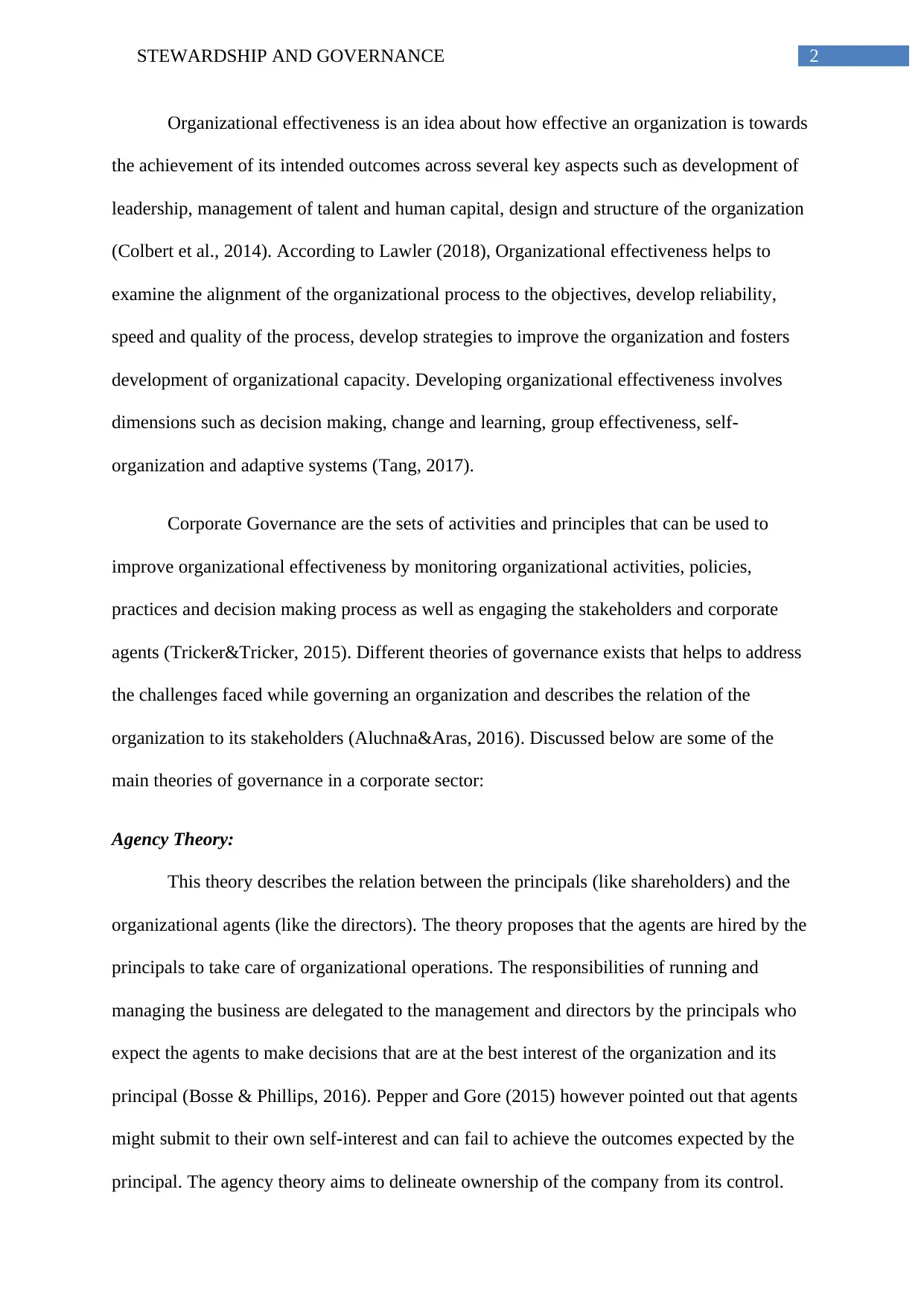
2STEWARDSHIP AND GOVERNANCE
Organizational effectiveness is an idea about how effective an organization is towards
the achievement of its intended outcomes across several key aspects such as development of
leadership, management of talent and human capital, design and structure of the organization
(Colbert et al., 2014). According to Lawler (2018), Organizational effectiveness helps to
examine the alignment of the organizational process to the objectives, develop reliability,
speed and quality of the process, develop strategies to improve the organization and fosters
development of organizational capacity. Developing organizational effectiveness involves
dimensions such as decision making, change and learning, group effectiveness, self-
organization and adaptive systems (Tang, 2017).
Corporate Governance are the sets of activities and principles that can be used to
improve organizational effectiveness by monitoring organizational activities, policies,
practices and decision making process as well as engaging the stakeholders and corporate
agents (Tricker&Tricker, 2015). Different theories of governance exists that helps to address
the challenges faced while governing an organization and describes the relation of the
organization to its stakeholders (Aluchna&Aras, 2016). Discussed below are some of the
main theories of governance in a corporate sector:
Agency Theory:
This theory describes the relation between the principals (like shareholders) and the
organizational agents (like the directors). The theory proposes that the agents are hired by the
principals to take care of organizational operations. The responsibilities of running and
managing the business are delegated to the management and directors by the principals who
expect the agents to make decisions that are at the best interest of the organization and its
principal (Bosse & Phillips, 2016). Pepper and Gore (2015) however pointed out that agents
might submit to their own self-interest and can fail to achieve the outcomes expected by the
principal. The agency theory aims to delineate ownership of the company from its control.
Organizational effectiveness is an idea about how effective an organization is towards
the achievement of its intended outcomes across several key aspects such as development of
leadership, management of talent and human capital, design and structure of the organization
(Colbert et al., 2014). According to Lawler (2018), Organizational effectiveness helps to
examine the alignment of the organizational process to the objectives, develop reliability,
speed and quality of the process, develop strategies to improve the organization and fosters
development of organizational capacity. Developing organizational effectiveness involves
dimensions such as decision making, change and learning, group effectiveness, self-
organization and adaptive systems (Tang, 2017).
Corporate Governance are the sets of activities and principles that can be used to
improve organizational effectiveness by monitoring organizational activities, policies,
practices and decision making process as well as engaging the stakeholders and corporate
agents (Tricker&Tricker, 2015). Different theories of governance exists that helps to address
the challenges faced while governing an organization and describes the relation of the
organization to its stakeholders (Aluchna&Aras, 2016). Discussed below are some of the
main theories of governance in a corporate sector:
Agency Theory:
This theory describes the relation between the principals (like shareholders) and the
organizational agents (like the directors). The theory proposes that the agents are hired by the
principals to take care of organizational operations. The responsibilities of running and
managing the business are delegated to the management and directors by the principals who
expect the agents to make decisions that are at the best interest of the organization and its
principal (Bosse & Phillips, 2016). Pepper and Gore (2015) however pointed out that agents
might submit to their own self-interest and can fail to achieve the outcomes expected by the
principal. The agency theory aims to delineate ownership of the company from its control.
⊘ This is a preview!⊘
Do you want full access?
Subscribe today to unlock all pages.

Trusted by 1+ million students worldwide
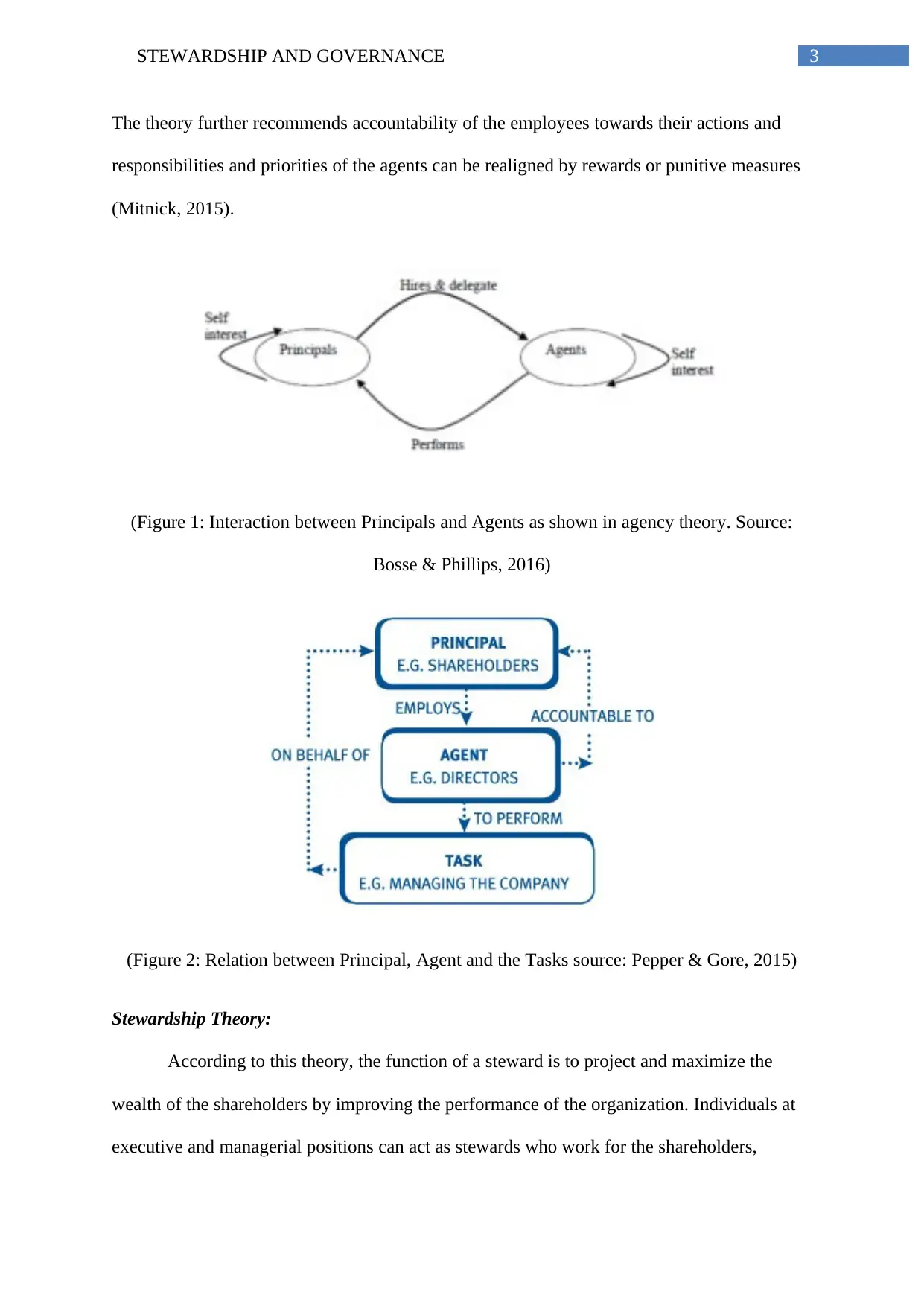
3STEWARDSHIP AND GOVERNANCE
The theory further recommends accountability of the employees towards their actions and
responsibilities and priorities of the agents can be realigned by rewards or punitive measures
(Mitnick, 2015).
(Figure 1: Interaction between Principals and Agents as shown in agency theory. Source:
Bosse & Phillips, 2016)
(Figure 2: Relation between Principal, Agent and the Tasks source: Pepper & Gore, 2015)
Stewardship Theory:
According to this theory, the function of a steward is to project and maximize the
wealth of the shareholders by improving the performance of the organization. Individuals at
executive and managerial positions can act as stewards who work for the shareholders,
The theory further recommends accountability of the employees towards their actions and
responsibilities and priorities of the agents can be realigned by rewards or punitive measures
(Mitnick, 2015).
(Figure 1: Interaction between Principals and Agents as shown in agency theory. Source:
Bosse & Phillips, 2016)
(Figure 2: Relation between Principal, Agent and the Tasks source: Pepper & Gore, 2015)
Stewardship Theory:
According to this theory, the function of a steward is to project and maximize the
wealth of the shareholders by improving the performance of the organization. Individuals at
executive and managerial positions can act as stewards who work for the shareholders,
Paraphrase This Document
Need a fresh take? Get an instant paraphrase of this document with our AI Paraphraser
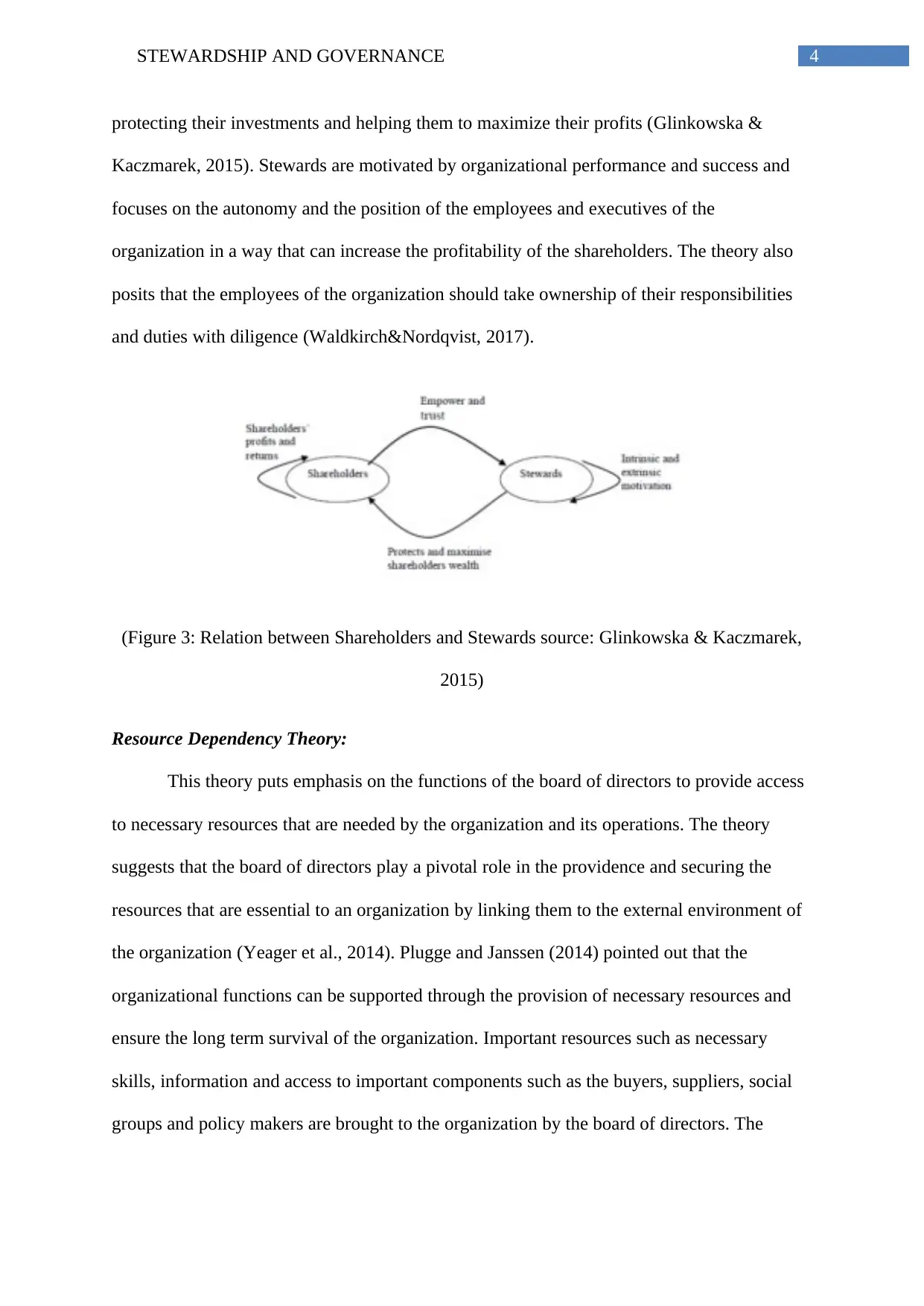
4STEWARDSHIP AND GOVERNANCE
protecting their investments and helping them to maximize their profits (Glinkowska &
Kaczmarek, 2015). Stewards are motivated by organizational performance and success and
focuses on the autonomy and the position of the employees and executives of the
organization in a way that can increase the profitability of the shareholders. The theory also
posits that the employees of the organization should take ownership of their responsibilities
and duties with diligence (Waldkirch&Nordqvist, 2017).
(Figure 3: Relation between Shareholders and Stewards source: Glinkowska & Kaczmarek,
2015)
Resource Dependency Theory:
This theory puts emphasis on the functions of the board of directors to provide access
to necessary resources that are needed by the organization and its operations. The theory
suggests that the board of directors play a pivotal role in the providence and securing the
resources that are essential to an organization by linking them to the external environment of
the organization (Yeager et al., 2014). Plugge and Janssen (2014) pointed out that the
organizational functions can be supported through the provision of necessary resources and
ensure the long term survival of the organization. Important resources such as necessary
skills, information and access to important components such as the buyers, suppliers, social
groups and policy makers are brought to the organization by the board of directors. The
protecting their investments and helping them to maximize their profits (Glinkowska &
Kaczmarek, 2015). Stewards are motivated by organizational performance and success and
focuses on the autonomy and the position of the employees and executives of the
organization in a way that can increase the profitability of the shareholders. The theory also
posits that the employees of the organization should take ownership of their responsibilities
and duties with diligence (Waldkirch&Nordqvist, 2017).
(Figure 3: Relation between Shareholders and Stewards source: Glinkowska & Kaczmarek,
2015)
Resource Dependency Theory:
This theory puts emphasis on the functions of the board of directors to provide access
to necessary resources that are needed by the organization and its operations. The theory
suggests that the board of directors play a pivotal role in the providence and securing the
resources that are essential to an organization by linking them to the external environment of
the organization (Yeager et al., 2014). Plugge and Janssen (2014) pointed out that the
organizational functions can be supported through the provision of necessary resources and
ensure the long term survival of the organization. Important resources such as necessary
skills, information and access to important components such as the buyers, suppliers, social
groups and policy makers are brought to the organization by the board of directors. The
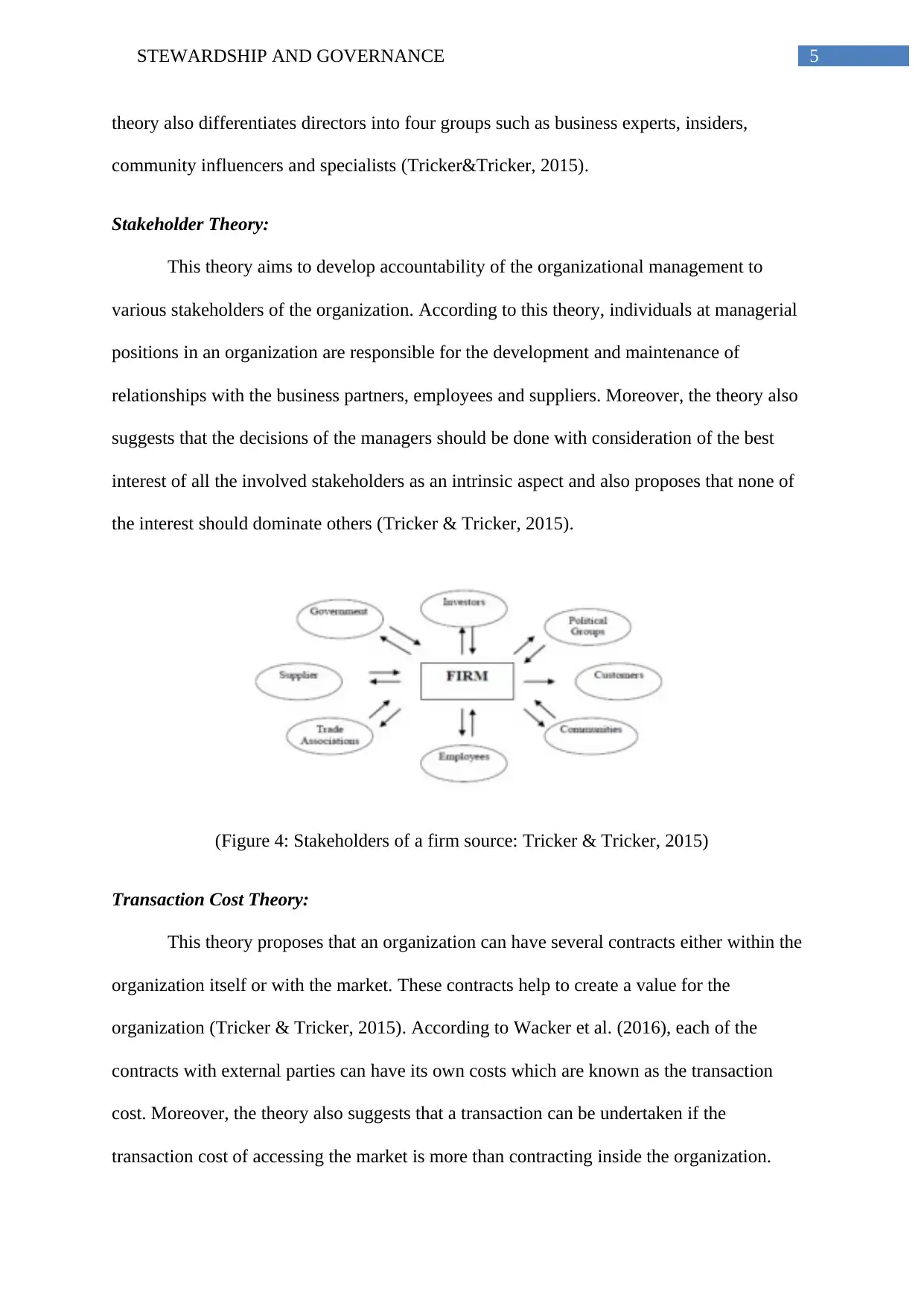
5STEWARDSHIP AND GOVERNANCE
theory also differentiates directors into four groups such as business experts, insiders,
community influencers and specialists (Tricker&Tricker, 2015).
Stakeholder Theory:
This theory aims to develop accountability of the organizational management to
various stakeholders of the organization. According to this theory, individuals at managerial
positions in an organization are responsible for the development and maintenance of
relationships with the business partners, employees and suppliers. Moreover, the theory also
suggests that the decisions of the managers should be done with consideration of the best
interest of all the involved stakeholders as an intrinsic aspect and also proposes that none of
the interest should dominate others (Tricker & Tricker, 2015).
(Figure 4: Stakeholders of a firm source: Tricker & Tricker, 2015)
Transaction Cost Theory:
This theory proposes that an organization can have several contracts either within the
organization itself or with the market. These contracts help to create a value for the
organization (Tricker & Tricker, 2015). According to Wacker et al. (2016), each of the
contracts with external parties can have its own costs which are known as the transaction
cost. Moreover, the theory also suggests that a transaction can be undertaken if the
transaction cost of accessing the market is more than contracting inside the organization.
theory also differentiates directors into four groups such as business experts, insiders,
community influencers and specialists (Tricker&Tricker, 2015).
Stakeholder Theory:
This theory aims to develop accountability of the organizational management to
various stakeholders of the organization. According to this theory, individuals at managerial
positions in an organization are responsible for the development and maintenance of
relationships with the business partners, employees and suppliers. Moreover, the theory also
suggests that the decisions of the managers should be done with consideration of the best
interest of all the involved stakeholders as an intrinsic aspect and also proposes that none of
the interest should dominate others (Tricker & Tricker, 2015).
(Figure 4: Stakeholders of a firm source: Tricker & Tricker, 2015)
Transaction Cost Theory:
This theory proposes that an organization can have several contracts either within the
organization itself or with the market. These contracts help to create a value for the
organization (Tricker & Tricker, 2015). According to Wacker et al. (2016), each of the
contracts with external parties can have its own costs which are known as the transaction
cost. Moreover, the theory also suggests that a transaction can be undertaken if the
transaction cost of accessing the market is more than contracting inside the organization.
⊘ This is a preview!⊘
Do you want full access?
Subscribe today to unlock all pages.

Trusted by 1+ million students worldwide
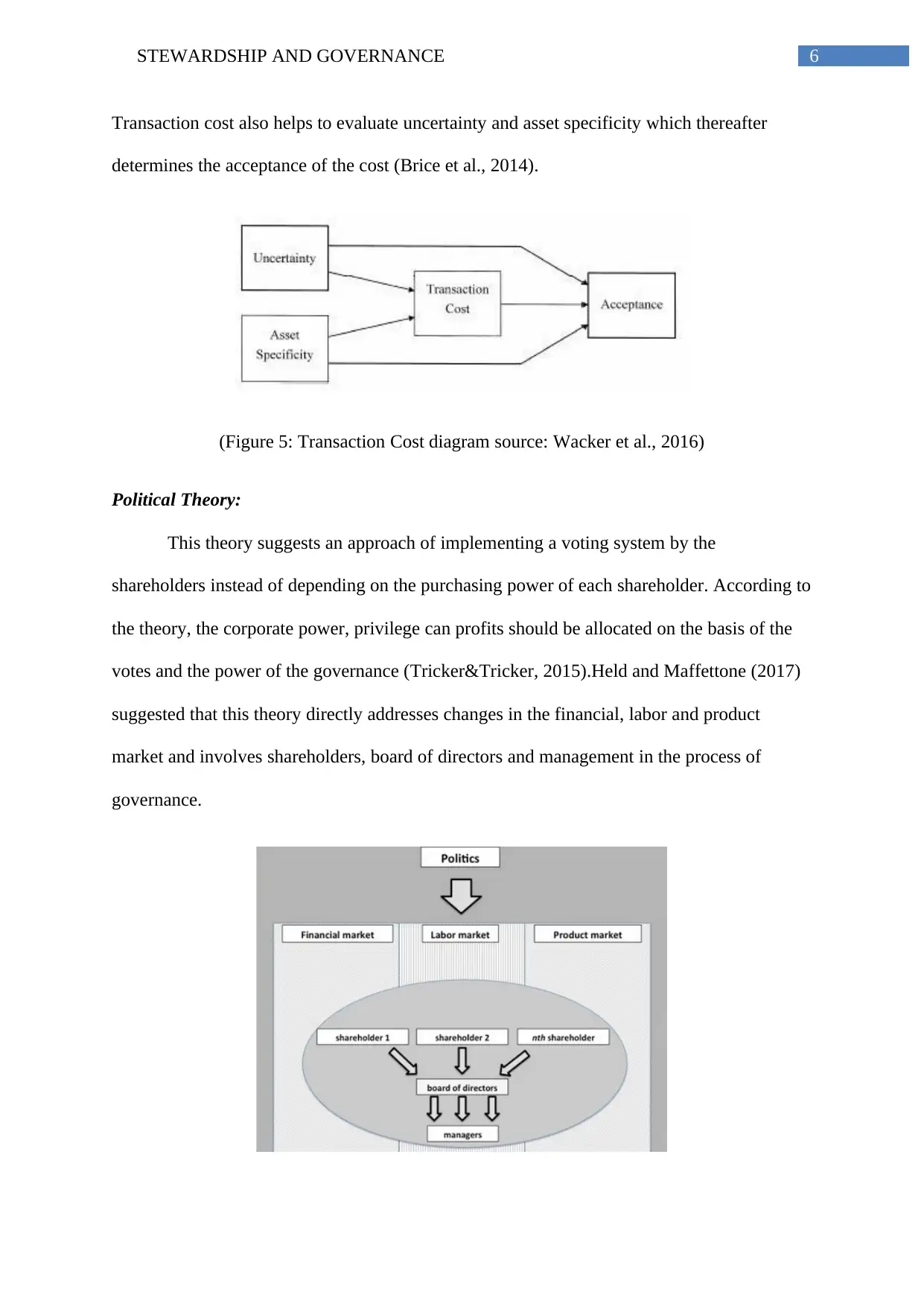
6STEWARDSHIP AND GOVERNANCE
Transaction cost also helps to evaluate uncertainty and asset specificity which thereafter
determines the acceptance of the cost (Brice et al., 2014).
(Figure 5: Transaction Cost diagram source: Wacker et al., 2016)
Political Theory:
This theory suggests an approach of implementing a voting system by the
shareholders instead of depending on the purchasing power of each shareholder. According to
the theory, the corporate power, privilege can profits should be allocated on the basis of the
votes and the power of the governance (Tricker&Tricker, 2015).Held and Maffettone (2017)
suggested that this theory directly addresses changes in the financial, labor and product
market and involves shareholders, board of directors and management in the process of
governance.
Transaction cost also helps to evaluate uncertainty and asset specificity which thereafter
determines the acceptance of the cost (Brice et al., 2014).
(Figure 5: Transaction Cost diagram source: Wacker et al., 2016)
Political Theory:
This theory suggests an approach of implementing a voting system by the
shareholders instead of depending on the purchasing power of each shareholder. According to
the theory, the corporate power, privilege can profits should be allocated on the basis of the
votes and the power of the governance (Tricker&Tricker, 2015).Held and Maffettone (2017)
suggested that this theory directly addresses changes in the financial, labor and product
market and involves shareholders, board of directors and management in the process of
governance.
Paraphrase This Document
Need a fresh take? Get an instant paraphrase of this document with our AI Paraphraser
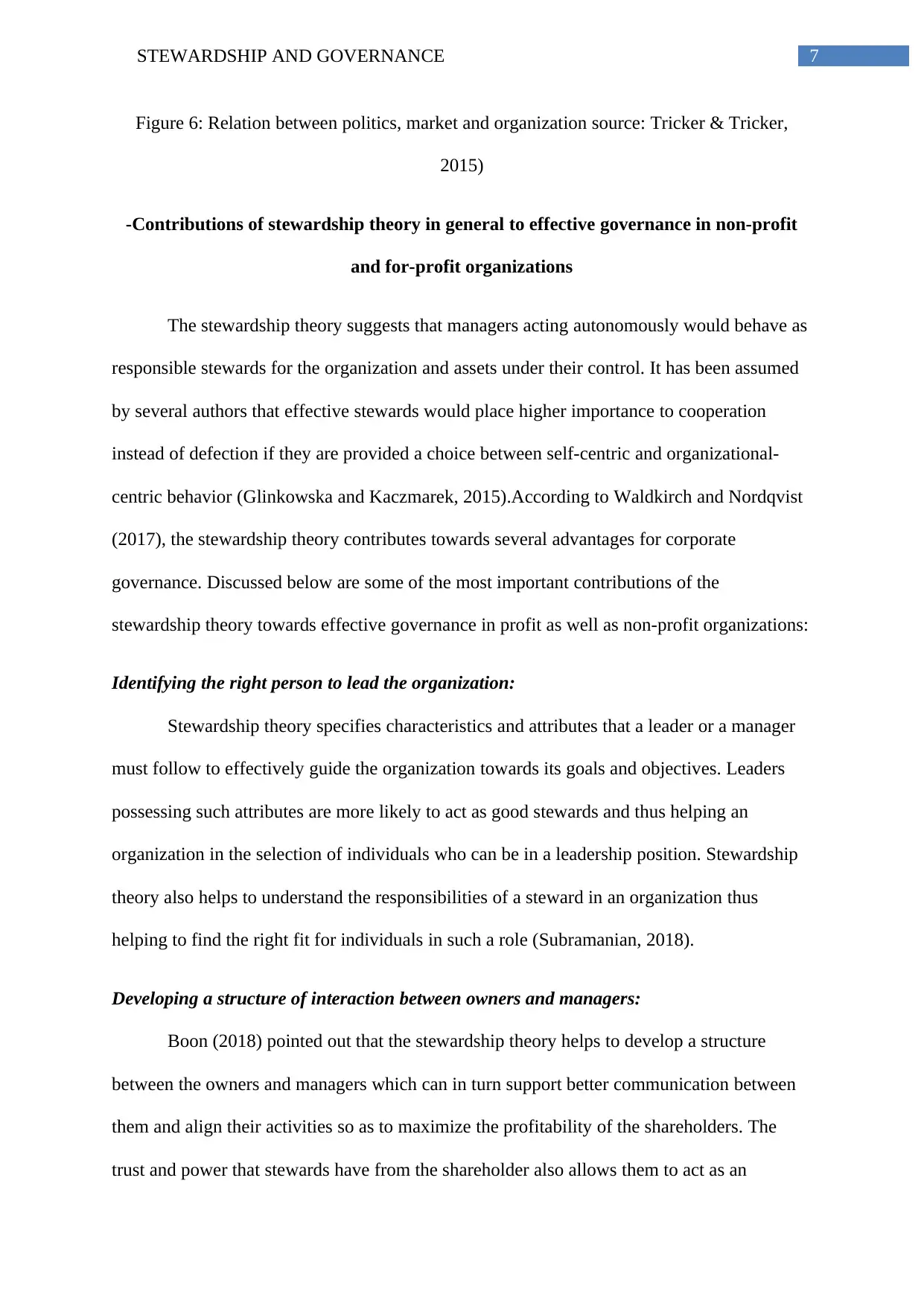
7STEWARDSHIP AND GOVERNANCE
Figure 6: Relation between politics, market and organization source: Tricker & Tricker,
2015)
-Contributions of stewardship theory in general to effective governance in non-profit
and for-profit organizations
The stewardship theory suggests that managers acting autonomously would behave as
responsible stewards for the organization and assets under their control. It has been assumed
by several authors that effective stewards would place higher importance to cooperation
instead of defection if they are provided a choice between self-centric and organizational-
centric behavior (Glinkowska and Kaczmarek, 2015).According to Waldkirch and Nordqvist
(2017), the stewardship theory contributes towards several advantages for corporate
governance. Discussed below are some of the most important contributions of the
stewardship theory towards effective governance in profit as well as non-profit organizations:
Identifying the right person to lead the organization:
Stewardship theory specifies characteristics and attributes that a leader or a manager
must follow to effectively guide the organization towards its goals and objectives. Leaders
possessing such attributes are more likely to act as good stewards and thus helping an
organization in the selection of individuals who can be in a leadership position. Stewardship
theory also helps to understand the responsibilities of a steward in an organization thus
helping to find the right fit for individuals in such a role (Subramanian, 2018).
Developing a structure of interaction between owners and managers:
Boon (2018) pointed out that the stewardship theory helps to develop a structure
between the owners and managers which can in turn support better communication between
them and align their activities so as to maximize the profitability of the shareholders. The
trust and power that stewards have from the shareholder also allows them to act as an
Figure 6: Relation between politics, market and organization source: Tricker & Tricker,
2015)
-Contributions of stewardship theory in general to effective governance in non-profit
and for-profit organizations
The stewardship theory suggests that managers acting autonomously would behave as
responsible stewards for the organization and assets under their control. It has been assumed
by several authors that effective stewards would place higher importance to cooperation
instead of defection if they are provided a choice between self-centric and organizational-
centric behavior (Glinkowska and Kaczmarek, 2015).According to Waldkirch and Nordqvist
(2017), the stewardship theory contributes towards several advantages for corporate
governance. Discussed below are some of the most important contributions of the
stewardship theory towards effective governance in profit as well as non-profit organizations:
Identifying the right person to lead the organization:
Stewardship theory specifies characteristics and attributes that a leader or a manager
must follow to effectively guide the organization towards its goals and objectives. Leaders
possessing such attributes are more likely to act as good stewards and thus helping an
organization in the selection of individuals who can be in a leadership position. Stewardship
theory also helps to understand the responsibilities of a steward in an organization thus
helping to find the right fit for individuals in such a role (Subramanian, 2018).
Developing a structure of interaction between owners and managers:
Boon (2018) pointed out that the stewardship theory helps to develop a structure
between the owners and managers which can in turn support better communication between
them and align their activities so as to maximize the profitability of the shareholders. The
trust and power that stewards have from the shareholder also allows them to act as an
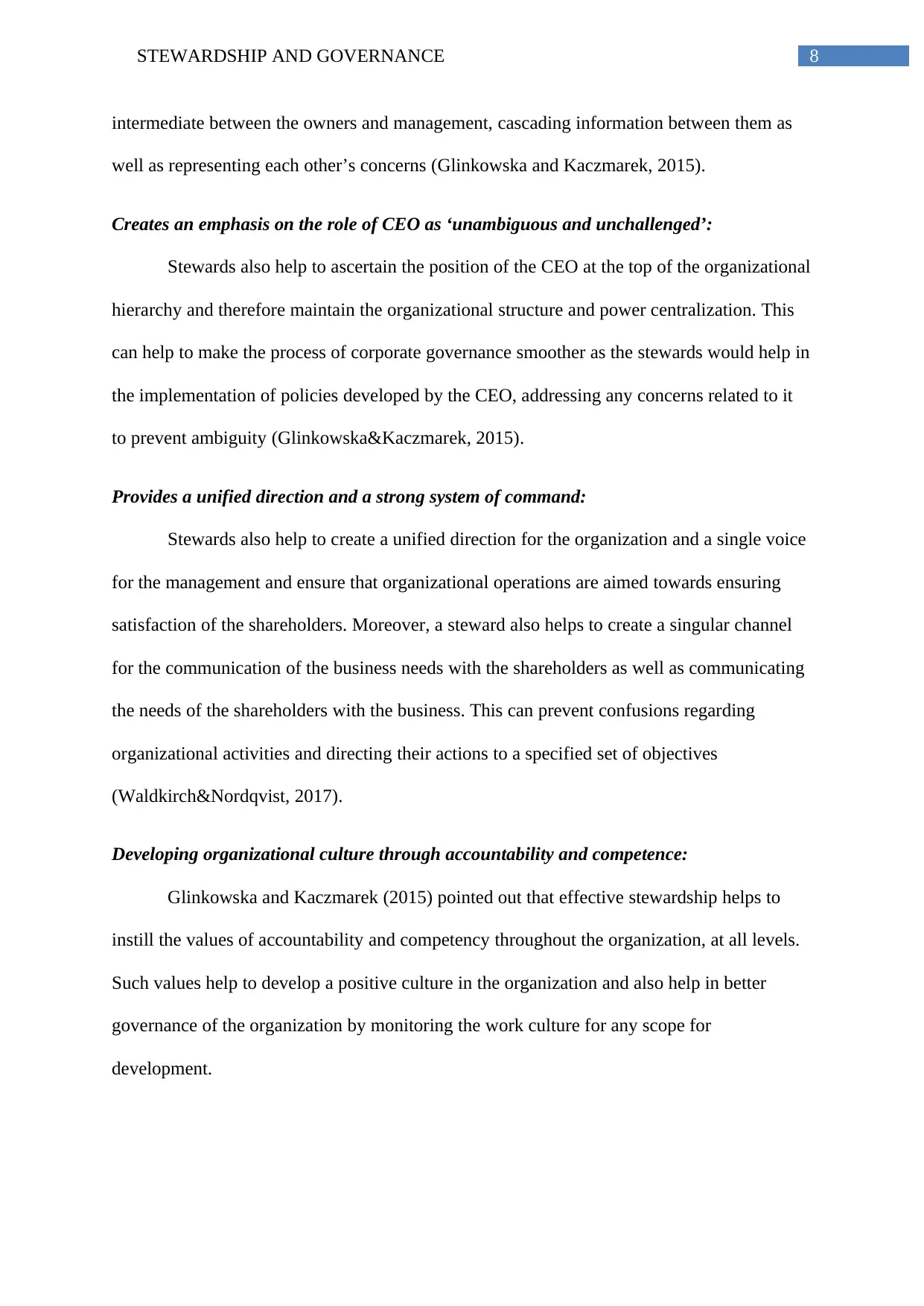
8STEWARDSHIP AND GOVERNANCE
intermediate between the owners and management, cascading information between them as
well as representing each other’s concerns (Glinkowska and Kaczmarek, 2015).
Creates an emphasis on the role of CEO as ‘unambiguous and unchallenged’:
Stewards also help to ascertain the position of the CEO at the top of the organizational
hierarchy and therefore maintain the organizational structure and power centralization. This
can help to make the process of corporate governance smoother as the stewards would help in
the implementation of policies developed by the CEO, addressing any concerns related to it
to prevent ambiguity (Glinkowska&Kaczmarek, 2015).
Provides a unified direction and a strong system of command:
Stewards also help to create a unified direction for the organization and a single voice
for the management and ensure that organizational operations are aimed towards ensuring
satisfaction of the shareholders. Moreover, a steward also helps to create a singular channel
for the communication of the business needs with the shareholders as well as communicating
the needs of the shareholders with the business. This can prevent confusions regarding
organizational activities and directing their actions to a specified set of objectives
(Waldkirch&Nordqvist, 2017).
Developing organizational culture through accountability and competence:
Glinkowska and Kaczmarek (2015) pointed out that effective stewardship helps to
instill the values of accountability and competency throughout the organization, at all levels.
Such values help to develop a positive culture in the organization and also help in better
governance of the organization by monitoring the work culture for any scope for
development.
intermediate between the owners and management, cascading information between them as
well as representing each other’s concerns (Glinkowska and Kaczmarek, 2015).
Creates an emphasis on the role of CEO as ‘unambiguous and unchallenged’:
Stewards also help to ascertain the position of the CEO at the top of the organizational
hierarchy and therefore maintain the organizational structure and power centralization. This
can help to make the process of corporate governance smoother as the stewards would help in
the implementation of policies developed by the CEO, addressing any concerns related to it
to prevent ambiguity (Glinkowska&Kaczmarek, 2015).
Provides a unified direction and a strong system of command:
Stewards also help to create a unified direction for the organization and a single voice
for the management and ensure that organizational operations are aimed towards ensuring
satisfaction of the shareholders. Moreover, a steward also helps to create a singular channel
for the communication of the business needs with the shareholders as well as communicating
the needs of the shareholders with the business. This can prevent confusions regarding
organizational activities and directing their actions to a specified set of objectives
(Waldkirch&Nordqvist, 2017).
Developing organizational culture through accountability and competence:
Glinkowska and Kaczmarek (2015) pointed out that effective stewardship helps to
instill the values of accountability and competency throughout the organization, at all levels.
Such values help to develop a positive culture in the organization and also help in better
governance of the organization by monitoring the work culture for any scope for
development.
⊘ This is a preview!⊘
Do you want full access?
Subscribe today to unlock all pages.

Trusted by 1+ million students worldwide
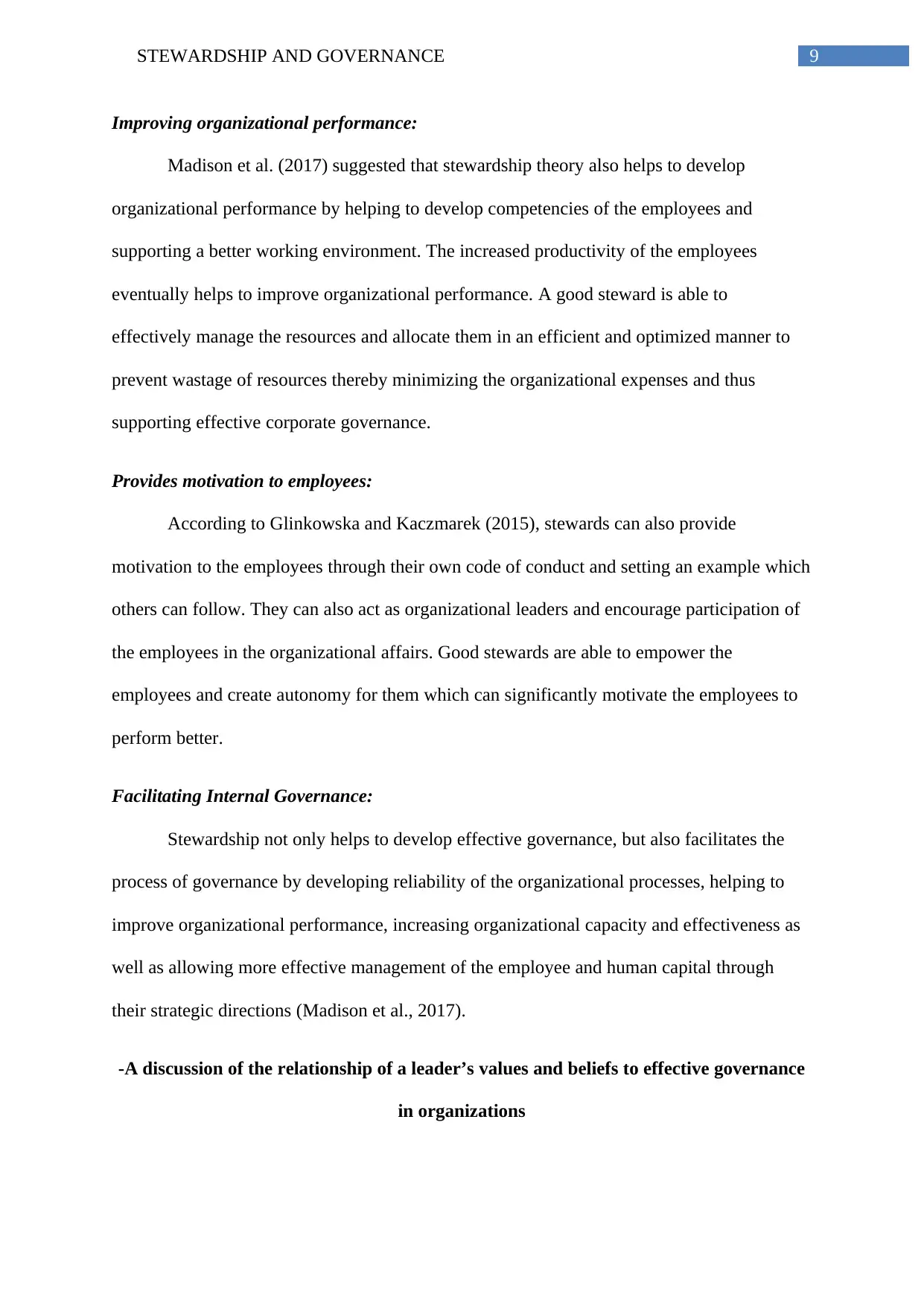
9STEWARDSHIP AND GOVERNANCE
Improving organizational performance:
Madison et al. (2017) suggested that stewardship theory also helps to develop
organizational performance by helping to develop competencies of the employees and
supporting a better working environment. The increased productivity of the employees
eventually helps to improve organizational performance. A good steward is able to
effectively manage the resources and allocate them in an efficient and optimized manner to
prevent wastage of resources thereby minimizing the organizational expenses and thus
supporting effective corporate governance.
Provides motivation to employees:
According to Glinkowska and Kaczmarek (2015), stewards can also provide
motivation to the employees through their own code of conduct and setting an example which
others can follow. They can also act as organizational leaders and encourage participation of
the employees in the organizational affairs. Good stewards are able to empower the
employees and create autonomy for them which can significantly motivate the employees to
perform better.
Facilitating Internal Governance:
Stewardship not only helps to develop effective governance, but also facilitates the
process of governance by developing reliability of the organizational processes, helping to
improve organizational performance, increasing organizational capacity and effectiveness as
well as allowing more effective management of the employee and human capital through
their strategic directions (Madison et al., 2017).
-A discussion of the relationship of a leader’s values and beliefs to effective governance
in organizations
Improving organizational performance:
Madison et al. (2017) suggested that stewardship theory also helps to develop
organizational performance by helping to develop competencies of the employees and
supporting a better working environment. The increased productivity of the employees
eventually helps to improve organizational performance. A good steward is able to
effectively manage the resources and allocate them in an efficient and optimized manner to
prevent wastage of resources thereby minimizing the organizational expenses and thus
supporting effective corporate governance.
Provides motivation to employees:
According to Glinkowska and Kaczmarek (2015), stewards can also provide
motivation to the employees through their own code of conduct and setting an example which
others can follow. They can also act as organizational leaders and encourage participation of
the employees in the organizational affairs. Good stewards are able to empower the
employees and create autonomy for them which can significantly motivate the employees to
perform better.
Facilitating Internal Governance:
Stewardship not only helps to develop effective governance, but also facilitates the
process of governance by developing reliability of the organizational processes, helping to
improve organizational performance, increasing organizational capacity and effectiveness as
well as allowing more effective management of the employee and human capital through
their strategic directions (Madison et al., 2017).
-A discussion of the relationship of a leader’s values and beliefs to effective governance
in organizations
Paraphrase This Document
Need a fresh take? Get an instant paraphrase of this document with our AI Paraphraser
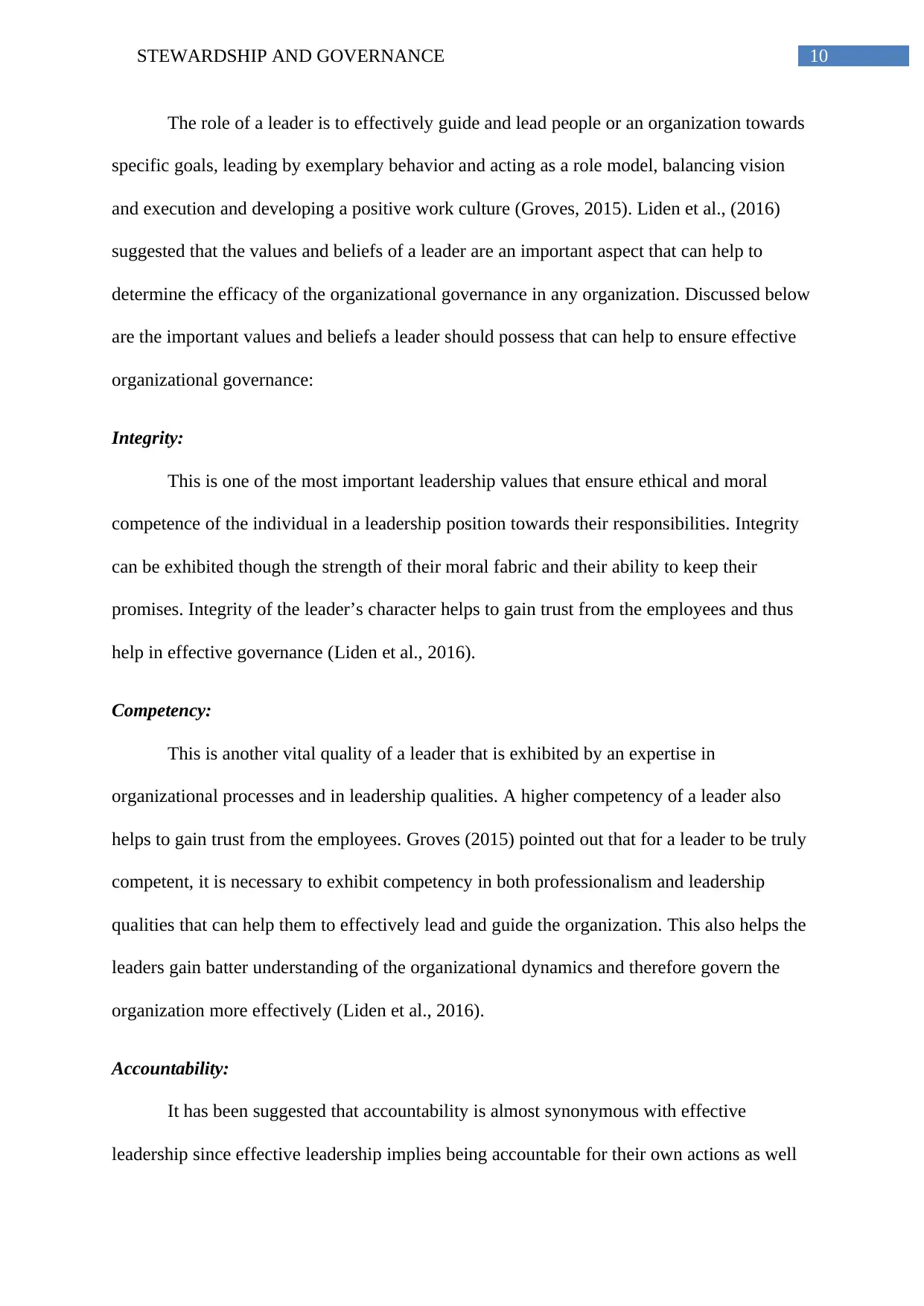
10STEWARDSHIP AND GOVERNANCE
The role of a leader is to effectively guide and lead people or an organization towards
specific goals, leading by exemplary behavior and acting as a role model, balancing vision
and execution and developing a positive work culture (Groves, 2015). Liden et al., (2016)
suggested that the values and beliefs of a leader are an important aspect that can help to
determine the efficacy of the organizational governance in any organization. Discussed below
are the important values and beliefs a leader should possess that can help to ensure effective
organizational governance:
Integrity:
This is one of the most important leadership values that ensure ethical and moral
competence of the individual in a leadership position towards their responsibilities. Integrity
can be exhibited though the strength of their moral fabric and their ability to keep their
promises. Integrity of the leader’s character helps to gain trust from the employees and thus
help in effective governance (Liden et al., 2016).
Competency:
This is another vital quality of a leader that is exhibited by an expertise in
organizational processes and in leadership qualities. A higher competency of a leader also
helps to gain trust from the employees. Groves (2015) pointed out that for a leader to be truly
competent, it is necessary to exhibit competency in both professionalism and leadership
qualities that can help them to effectively lead and guide the organization. This also helps the
leaders gain batter understanding of the organizational dynamics and therefore govern the
organization more effectively (Liden et al., 2016).
Accountability:
It has been suggested that accountability is almost synonymous with effective
leadership since effective leadership implies being accountable for their own actions as well
The role of a leader is to effectively guide and lead people or an organization towards
specific goals, leading by exemplary behavior and acting as a role model, balancing vision
and execution and developing a positive work culture (Groves, 2015). Liden et al., (2016)
suggested that the values and beliefs of a leader are an important aspect that can help to
determine the efficacy of the organizational governance in any organization. Discussed below
are the important values and beliefs a leader should possess that can help to ensure effective
organizational governance:
Integrity:
This is one of the most important leadership values that ensure ethical and moral
competence of the individual in a leadership position towards their responsibilities. Integrity
can be exhibited though the strength of their moral fabric and their ability to keep their
promises. Integrity of the leader’s character helps to gain trust from the employees and thus
help in effective governance (Liden et al., 2016).
Competency:
This is another vital quality of a leader that is exhibited by an expertise in
organizational processes and in leadership qualities. A higher competency of a leader also
helps to gain trust from the employees. Groves (2015) pointed out that for a leader to be truly
competent, it is necessary to exhibit competency in both professionalism and leadership
qualities that can help them to effectively lead and guide the organization. This also helps the
leaders gain batter understanding of the organizational dynamics and therefore govern the
organization more effectively (Liden et al., 2016).
Accountability:
It has been suggested that accountability is almost synonymous with effective
leadership since effective leadership implies being accountable for their own actions as well

11STEWARDSHIP AND GOVERNANCE
as the actions of the subordinates. Moreover, a leader should be accountable and responsible
for the decisions, policies, products, organizational governance, administration and
implementation of policies and be answerable for the ensuing consequences to the
shareholders (Ciulla, 2017). Accountability also ensures that the leaders show liability
towards the achievement of organizational objectives or failure to do so. Liden et al. (2016)
suggested that an accountable leader is trusted and respected by their subordinates which help
in effective governance of the organization.
Courage and confidence:
A good leader should also show courage and confidence in their own actions and
decisions and should be able to instill the same among the subordinates. Through higher
confidence and courage, a leader can help to encourage the employees towards better
performance and productivity as well as guide the organization through difficult times
(Ciulla, 2017).
Honesty and transparency:
Liden et al. (2016) suggested that a good leader also should be honest and transparent
to their subordinates and stakeholders. The honesty and transparency helps to prevent
ambiguity and confusion and instead gain confidence from both shareholders and
subordinates. The confidence from the subordinates further helps a leader to govern the
organization more effectively (Ciulla, 2017).
Commitment:
A good leader should also be committed towards the development of the organization
and upholding the organizational values and policies. A committed leaders also highly driven
to achieve the organizational goals, supporting the subordinates to achieve better performance
as the actions of the subordinates. Moreover, a leader should be accountable and responsible
for the decisions, policies, products, organizational governance, administration and
implementation of policies and be answerable for the ensuing consequences to the
shareholders (Ciulla, 2017). Accountability also ensures that the leaders show liability
towards the achievement of organizational objectives or failure to do so. Liden et al. (2016)
suggested that an accountable leader is trusted and respected by their subordinates which help
in effective governance of the organization.
Courage and confidence:
A good leader should also show courage and confidence in their own actions and
decisions and should be able to instill the same among the subordinates. Through higher
confidence and courage, a leader can help to encourage the employees towards better
performance and productivity as well as guide the organization through difficult times
(Ciulla, 2017).
Honesty and transparency:
Liden et al. (2016) suggested that a good leader also should be honest and transparent
to their subordinates and stakeholders. The honesty and transparency helps to prevent
ambiguity and confusion and instead gain confidence from both shareholders and
subordinates. The confidence from the subordinates further helps a leader to govern the
organization more effectively (Ciulla, 2017).
Commitment:
A good leader should also be committed towards the development of the organization
and upholding the organizational values and policies. A committed leaders also highly driven
to achieve the organizational goals, supporting the subordinates to achieve better performance
⊘ This is a preview!⊘
Do you want full access?
Subscribe today to unlock all pages.

Trusted by 1+ million students worldwide
1 out of 19
Related Documents
Your All-in-One AI-Powered Toolkit for Academic Success.
+13062052269
info@desklib.com
Available 24*7 on WhatsApp / Email
![[object Object]](/_next/static/media/star-bottom.7253800d.svg)
Unlock your academic potential
Copyright © 2020–2025 A2Z Services. All Rights Reserved. Developed and managed by ZUCOL.





